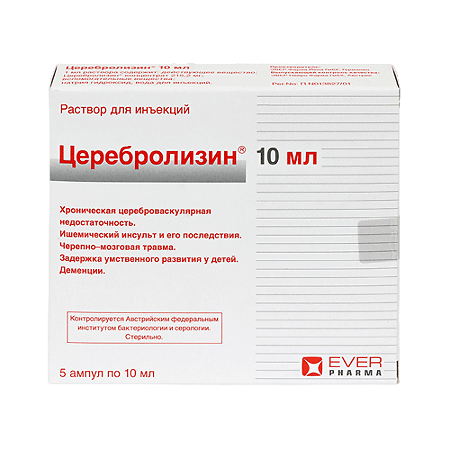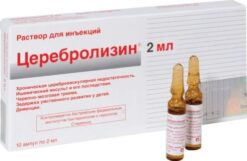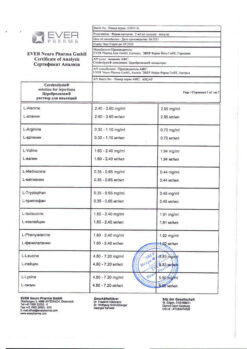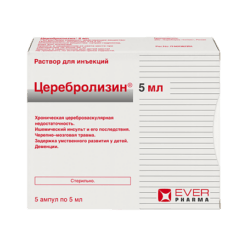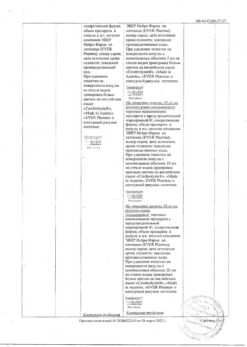No products in the cart.
Cerebrolysin, 10 ml 5 pcs
€44.93 €37.44
Description
Cerebrolysin is a stimulator of neurometabolic processes (has nootropic effect).
Deproteinized hydrolysate of pig brain substance stimulates cell differentiation processes, improves the functional state of cells of the nervous system and activates mechanisms of protection and renewal.
The experiments conducted on animals have shown that the amino acids and peptides contained in Cerebrolysine have a direct effect on neuronal and synaptic plasticity, which in turn improves higher brain functions.
Indications
Indications
Alzheimer’s disease;
dementia syndrome of various origins;
chronic cerebrovascular insufficiency;
ischemic stroke;
traumatic injuries of the brain and spinal cord;
mental retardation in children;
hyperactivity and attention deficit in children;
in complex therapy for endogenous depression resistant to antidepressants.
Pharmacological effect
Pharmacological effect
Cerebrolysin is a stimulator of neurometabolic processes (has a nootropic effect).
Deproteinized hydrolyzate of pig brain substance stimulates cell differentiation processes, improves the functional state of cells of the nervous system and activates mechanisms of protection and renewal.
Experiments conducted on animals have shown that the biologically active amino acids and peptides contained in Cerebrolysin have a direct effect on neuronal and synaptic plasticity, which in turn helps to improve higher brain functions.
Special instructions
Special instructions
The compatibility of the drug has been tested and confirmed (within 24 hours at room temperature and light) with the following standard solutions for infusion:
0.9% sodium chloride solution (9 mg NaCl/ml);
Ringer’s solution (Na+ – 153.98 mmol/l; Ca2+ – 2.74 mmol/l; K+ – 4.02 mmol/l; Cl− – 163.48 mmol/l).
5% glucose solution.
The simultaneous administration of Cerebrolysin with vitamins and drugs that improve cardiac circulation is allowed, but these drugs should not be mixed in the same syringe with Cerebrolysin. Only use a clear solution and only once.
Impact on the ability to drive vehicles and operate machinery. Clinical trials have shown that Cerebrolysin does not affect the ability to drive vehicles and use machinery.
Active ingredient
Active ingredient
Brain peptide complex
Composition
Composition
Active substance:
1 ml of an aqueous solution of the drug contains 215.2 mg of Cerebrolysin concentrate (a complex of peptides obtained from the pig brain).
The active fraction of Cerebrolysin is represented by peptides,
whose molecular weight does not exceed 10,000 daltons.
Excipients
sodium hydroxide and water for injection.
Pregnancy
Pregnancy
The drug is prescribed with caution in the first trimester of pregnancy and during lactation.
During pregnancy and breastfeeding, Cerebrolysin should be used only after a thorough analysis of the relationship between the positive effect of treatment and the risk associated with it.
The results of experimental studies do not give reason to believe that Cerebrolysin has a teratogenic effect or has a toxic effect on the fetus.
However, similar clinical studies have not been conducted.
Contraindications
Contraindications
individual intolerance to the drug;
acute renal failure;
status epilepticus.
Side Effects
Side Effects
Reaction to administration: with excessively rapid administration, in rare cases, a feeling of heat, sweating, and dizziness may occur; in isolated cases – rapid heartbeat or arrhythmias. Therefore, the drug should be administered slowly.
From the gastrointestinal tract: rarely – loss of appetite, dyspepsia, diarrhea, constipation, nausea and vomiting.
From the central nervous system and peripheral nervous system: in rare cases, the expected effect of activation was accompanied by agitation (manifested by aggressive behavior, confusion, insomnia). There are reports of the occurrence in isolated cases (
From the immune system: extremely rarely – hypersensitivity reactions or allergic reactions, manifested by headache, pain in the neck, limbs, lower back, shortness of breath, chills and collapsing state.
Local reactions: rarely – redness of the skin, itching and burning at the injection site.
Other: extremely rare – studies have reported cases of hyperventilation, arterial hypertension, hypotension, fatigue, tremor, depression, apathy, dizziness and flu-like symptoms (cough, runny nose, respiratory tract infections).
It should be noted that some undesirable effects (excitement, arterial hypertension, arterial hypotension, lethargy, tremor, depression, apathy, dizziness, headache, shortness of breath, diarrhea, nausea) were identified during clinical trials and occurred equally in patients receiving Cerebrolysin and in patients in the placebo group.
Interaction
Interaction
Taking into account the pharmacological profile of the drug Cerebrolysin, special attention should be paid to possible additive effects when co-administered with antidepressants, incl. MAO inhibitors. In such cases, it is recommended to reduce the dose of the antidepressant.
Cerebrolysin and balanced solutions of amino acids should not be mixed in the same solution for infusion.
Cerebrolysin is incompatible with solutions containing lipids and with solutions that change the pH of the medium (5–8).
Storage conditions
Storage conditions
The drug should be stored in a place protected from light at a temperature not exceeding 25°C.
Shelf life
Shelf life
5 years.
Manufacturer
Manufacturer
EVER Pharma Jena GmbH, Germany
Additional information
| Shelf life | 5 years. |
|---|---|
| Conditions of storage | The drug should be stored in the dark place at a temperature not exceeding 25°C. |
| Manufacturer | EVER Pharma Jena GmbH, Germany |
| Medication form | solution for injection |
| Brand | EVER Pharma Jena GmbH |
Other forms…
Related products
Buy Cerebrolysin, 10 ml 5 pcs with delivery to USA, UK, Europe and over 120 other countries.

